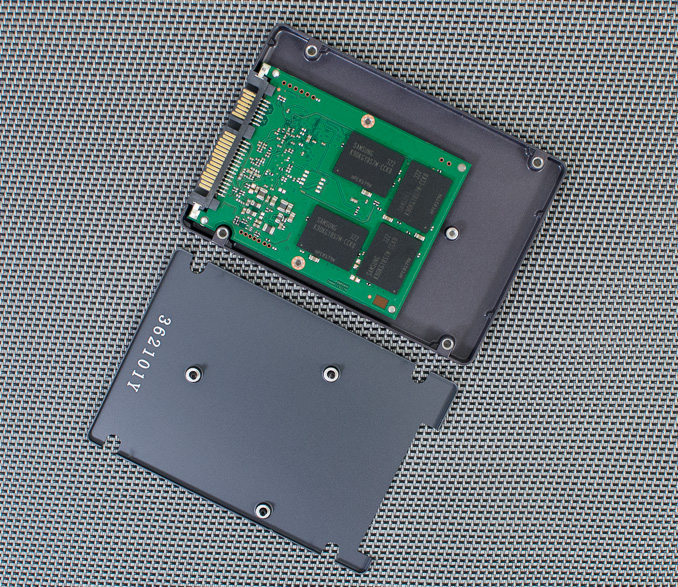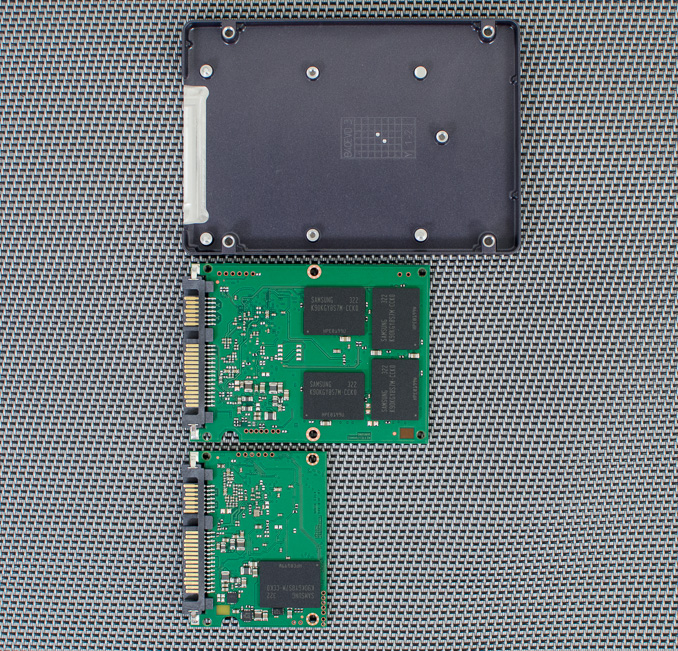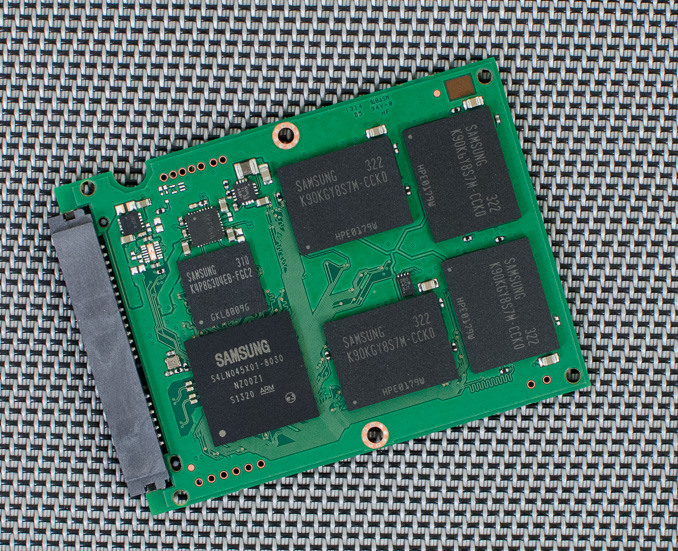Samsung SSD 840 EVO Review: 120GB, 250GB, 500GB, 750GB & 1TB Models Tested
by Anand Lal Shimpi on July 25, 2013 1:53 PM EST- Posted in
- Storage
- SSDs
- Samsung
- TLC
- Samsung SSD 840
Inside the Drives & Spare Area
The EVO is offered in a single form factor - 2.5" at a 7mm thickness. There are three torx (T5) screws that hold the chassis together, removing them gets you a look at the EVO's very simple internals. Surprisingly enough there's no thermal pad between Samsung's MEX controller and the chassis.
Samsung, like Intel, does a great job of reducing the number of screws and simplifying the assembly of its drives. I would prefer if Samsung didn't insist on using torx screws to hold the chassis together but I'm sure it does have some impact on reducing returns. There's also growing concern of counterfit SSDs which I guess screw choice could somewhat address.
There are two PCB sizes used in the EVO lineup, neither of which occupies the full volume of the 2.5"/7mm chassis. The 120 and 250GB drives use the smallest PCB, while the other drives use the larger layout. The larger PCB has room for 8 NAND packages, while the half length PCB can accommodate two. Each of the NAND packages can hold up to 8 x 128Gbit 19nm TLC die.
To deal with the realities of TLC, Samsung sets aside more of the drive for use as spare area on the EVO than it does on its MLC Pro line. Due to TurboWrite however, the percentage is actually a bit less than it was on last year's 840.
| Samsung SSD 840 EVO Memory | |||||||
| Advertised Capacity | 120GB | 250GB | 500GB | 750GB | 1TB | ||
| DRAM Size | 256MB LPDDR2-1066 | 512MB LPDDR2-1066 | 512MB LPDDR2-1066 | 1GB LPDDR2-1066 | 1GB LPDDR2-1066 | ||
| # of NAND Packages | 2 | 2 | 4 | 8 | 8 | ||
| # of NAND die per Package | 4 | 8 | 8 | 4 | 8 | ||
| NAND Capacity per Package | 64 GiB | 128 GiB | 128 GiB | 96 GiB | 128 GiB | ||
| Total NAND | 128 GiB | 256 GiB | 512 GiB | 768 GiB | 1024 GiB | ||
| Spare Area | 12.7% | 9.05% | 9.05% | 9.05% | 9.05% | ||
I've tossed internal shots of all of the EVO lineup into the gallery below:



















137 Comments
View All Comments
spazoid - Thursday, July 25, 2013 - link
It's free. Free is better.jhh - Thursday, July 25, 2013 - link
Are there any latency measurements in milliseconds as opposed to IOPS? With IOPS, the drive may be queuing rquests, making it difficult to translate IOPS to milliseconds per request.Kibbles - Thursday, July 25, 2013 - link
If I write 1gb/day on average to my SSD, since media files go on my home server, this drive would last me 395 years LOL!sheh - Thursday, July 25, 2013 - link
Anand, would you consider writing an article on the other aspect of endurance: data retention time? With TLC entering the fray it's starting to get even more worrying.It'd be interesting to know how retention time changes throughout a drive's life, trends in the last few years, differences between manufacturers, the effect of the JEDEC standard, whether there's any idle-time refreshing for old written cells, etc.
And an idea: I'd like to see drives where you can configure whether to use the drive as SLC/MLC/TLC. Switch to SLC for reliability/performance, TLC for capacity.
MrSpadge - Saturday, July 27, 2013 - link
"And an idea: I'd like to see drives where you can configure whether to use the drive as SLC/MLC/TLC. Switch to SLC for reliability/performance, TLC for capacity."Or a drive which switches blocks from TLC operation to MLC as it runs out of writes cycles. And finally to SLC.. at which point in time it should last pretty much infinitely.
mgl888 - Thursday, July 25, 2013 - link
Great article.Does RAPID require that you install a separate driver or does it just work automatically out of the box? What's the support like for Linux?
bobbozzo - Friday, July 26, 2013 - link
It's a driver, for Windows.TheinsanegamerN - Saturday, July 27, 2013 - link
and i dont think that rapid has a reason to be on linux. linux is already much better with ssd writes than windows.chizow - Thursday, July 25, 2013 - link
Minor spelling correction: http://www.anandtech.com/show/7173/samsung-ssd-840..."counterfit" should be "counterfeit"
chizow - Thursday, July 25, 2013 - link
Nice review Anand, I'm really glad to see almost all the top SSDs from numerous makers (Samsung, Crucial, SanDisk, Intel) are creeping up and exceeding SATA2 specs across the board and nearly saturating SATA3 specs.It really is amazing though how Samsung seems to be dominating the SSD landscape. I know this review is a bit skewed though since you presumably tried to include almost all the Samsung capacity offerings (for comparison sake), but the impact of the 840, 840 Pro and now the 840 EVO on the SSD market are undeniable. They really have no weaknesses, other than perhaps the Seq. Write Speeds on the 840/EVO.
I guess this is why there's so many deals currently on the 840, I bought the 250GB version earlier this month and don't really regret it given the price I got it for, but the EVO is certainly a step up in nearly every aspect.